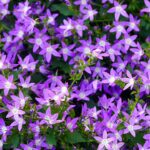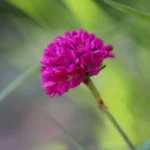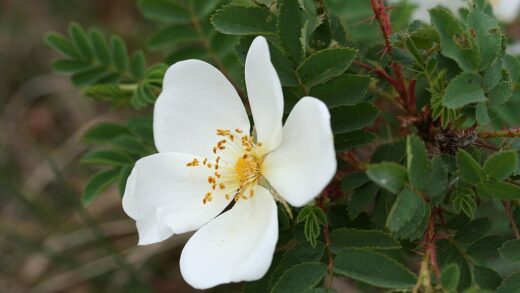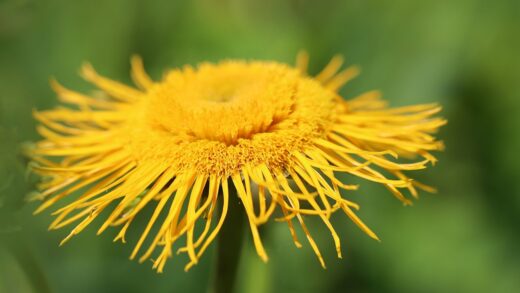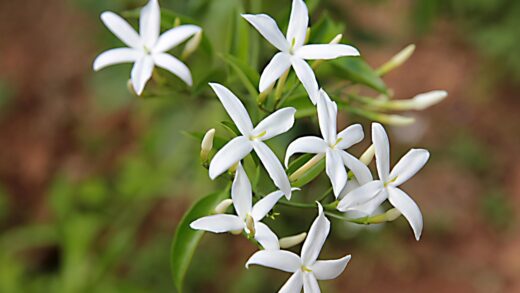True to its rugged and wild heritage, the sloe is a remarkably robust and healthy shrub, generally untroubled by the wide array of diseases and pests that can afflict more highly bred fruit trees. Its long history of thriving in natural environments without human intervention has endowed it with a strong constitution and a natural resistance to many common ailments. In a garden setting, a well-sited sloe, growing in sunny, well-drained conditions, is very likely to live its entire life without any significant health problems. This inherent resilience is one of its most appealing characteristics for the low-maintenance gardener. However, no plant is entirely immune, and it is wise to be aware of the few potential issues that can occasionally arise.
When problems do occur, they are often linked to environmental stress or suboptimal growing conditions. A sloe that is stressed by factors such as waterlogged soil, deep shade, or prolonged drought will have its natural defenses weakened, making it more vulnerable to attack by pathogens or insects. Therefore, the first and most effective line of defense against diseases and pests is preventative care. By providing the plant with its preferred growing conditions from the outset, you are creating a strong, vigorous shrub that is well-equipped to fend off most potential threats on its own.
The most notable disease that can affect sloe is a fungal infection called Taphrina pruni, which causes a condition known as ‘pocket plum’. This disease distorts the developing fruit, making it elongated, flattened, and hollow, without a stone inside. While visually alarming, it rarely poses a serious threat to the overall health of the tree. Pests are also an infrequent concern, though aphids may sometimes colonize the tips of new shoots in the spring, and the larvae of certain moths may feed on the leaves.
In most cases, managing these issues does not require the use of chemical sprays. A healthy garden ecosystem, rich in biodiversity, will typically provide natural predators—such as ladybirds, hoverflies, and birds—that keep pest populations in check. For diseases, simple measures of garden hygiene, like removing and destroying infected material, are often sufficient to control their spread. An observant and preventative approach is the key to keeping your sloe healthy, ensuring that intervention is a rare necessity rather than a regular chore.
Common fungal diseases
By far the most specific and recognizable disease to affect the sloe is caused by the fungus Taphrina pruni. This disease is responsible for a condition commonly referred to as pocket plum. The infection occurs during the flowering period in spring, but its symptoms only become apparent as the fruits begin to develop in early summer. The fungus stimulates the fruit to grow abnormally, resulting in sloes that are misshapen, elongated, and often slightly curved. These affected fruits are hollow, lacking the characteristic hard stone in the center, and are covered in a whitish bloom of fungal spores before they wither and drop from the plant.
More articles on this topic
While the appearance of pocket plum can be alarming, it is important to note that it is not a life-threatening disease for the shrub. It primarily affects the fruit for that particular season and does not typically cause long-term damage to the branches or root system. The severity of the infection can vary greatly from year to year, often being more prevalent following a cool, wet spring, which provides the ideal conditions for the fungal spores to germinate and infect the flowers. In a dry spring, you may see very few, if any, affected fruits.
Control of pocket plum is centered around garden hygiene. There are no chemical fungicides available to home gardeners that are effective against this specific disease. The best course of action is to be vigilant and remove any infected, distorted fruits as soon as you notice them. This should be done before they develop the white, spore-producing layer, as this will help to reduce the amount of fungal inoculum that can survive to re-infect the plant the following year. Collected fruits should be disposed of by burning or in household waste, not added to the compost heap.
For established shrubs that suffer from severe infections year after year, some gardeners find that a hard regenerative pruning can be beneficial. By cutting the shrub back significantly in the winter, you remove a large amount of wood that may be harboring dormant fungal spores. As the shrub regrows with fresh, new wood, it may experience a few years with a much lower incidence of the disease. However, for most minor infections, simply removing the affected fruit is a perfectly adequate and proportionate response.
Key insect pests
The sloe is not a primary target for many insect pests, but like most plants in the Prunus genus, it can occasionally play host to aphids. These small, sap-sucking insects typically congregate on the soft, new growth at the tips of the branches in late spring and early summer. A small infestation is generally not a cause for concern, as a healthy sloe can easily tolerate their presence. In a balanced garden ecosystem, natural predators such as ladybirds, lacewings, and the larvae of hoverflies will soon arrive and keep the aphid population under control.
More articles on this topic
If an aphid infestation becomes particularly heavy, it can cause some curling and distortion of the new leaves and may lead to a sticky residue, known as honeydew, on the foliage below. This honeydew can, in turn, attract sooty mould, a black fungus that grows on the sweet substance. While this is unsightly, it does not directly harm the plant. In most cases, you can simply ignore the aphids or, if you feel action is needed, a strong jet of water from a hose can be used to dislodge a large number of them from the shoots.
The leaves of the sloe provide food for the caterpillars of a number of beautiful moth species, such as the lackey moth, the small eggar, and the brown hairstreak butterfly. Seeing some evidence of caterpillar feeding, such as chewed leaf margins, should be viewed as a positive sign that your shrub is playing its valuable role in the local ecosystem. These caterpillars rarely cause significant defoliation or harm to a healthy plant, and they provide an important food source for birds. Intervention is almost never necessary or desirable.
Occasionally, you might find scale insects, which appear as small, barnacle-like bumps on the stems and twigs. Like aphids, they feed on sap, but heavy infestations are very rare on sloe. If you do find a localized cluster of scale insects, they can often be scraped off with a thumbnail or a small brush. In general, the best approach to insect pests on sloe is one of tolerance and observation, allowing the natural balance of predators and prey in your garden to manage the situation without resorting to chemical insecticides, which can do more harm than good by killing beneficial insects.
Recognizing environmental stress
Often, what may appear to be a symptom of a disease is actually a sign of environmental stress. It is crucial to distinguish between the two, as the remedies are completely different. For example, yellowing leaves (chlorosis) are a common symptom. If this is caused by a nutrient deficiency, the pattern of yellowing might be specific. However, if it is caused by waterlogged soil and poor drainage, the entire leaf may turn yellow, and the plant will likely show stunted growth. The solution in this case is not to add fertilizer, but to address the underlying drainage problem.
Drought stress is another major environmental factor that can impact the sloe’s health, particularly for young, unestablished plants. Symptoms include wilting, browning or scorching at the leaf edges, and premature leaf drop. These signs indicate that the plant is not able to take up enough water to meet its needs. While a mature sloe is very drought-tolerant, a young one needs consistent moisture. Recognizing these symptoms early and providing a deep, thorough watering can prevent long-term damage to the shrub.
Frost damage can also be a concern, particularly late frosts in the spring that occur after the sloe has produced its blossoms. The flowers of the sloe are its most delicate part, and a hard frost can kill them, turning them brown and causing them to drop. This will result in a failure to produce fruit for that year. While this is disappointing, it does not harm the long-term health of the shrub itself. There is little that can be done to prevent this in an open garden, but it is important to recognize it as a weather-related event rather than a disease.
Physical damage from wind, animals, or gardening activities can create wounds in the bark. These open wounds can serve as entry points for bacterial or fungal pathogens. While the sloe is generally good at healing itself, it is wise to prune away any broken or torn branches cleanly to promote rapid callusing. By correctly identifying these environmental and physical stressors, you can take appropriate action and avoid misdiagnosing the problem, ensuring you provide the right care for your plant.
Integrated pest and disease management
The most effective and sustainable approach to managing health issues on a sloe is to adopt the principles of Integrated Pest Management (IPM). This is a holistic strategy that prioritizes prevention and natural controls over chemical intervention. The foundation of IPM is to create a healthy, resilient plant from the very beginning. This means choosing a suitable planting site with plenty of sun and good drainage, preparing the soil well, and providing adequate water during the establishment phase. A strong, healthy plant is its own best defense against pests and diseases.
The next level of IPM involves encouraging biodiversity in your garden. By cultivating a range of different plants, you will attract a wide variety of beneficial insects, birds, and other animals. These creatures are the natural predators of common garden pests. For instance, ladybirds and their larvae can consume hundreds of aphids, while birds will readily feed on caterpillars. By avoiding the use of broad-spectrum insecticides, you protect these valuable allies and allow them to perform their natural pest control services for free. Creating habitats like log piles or leaving a patch of long grass can further support this beneficial wildlife.
Regular monitoring is also a key component of IPM. A frequent walk around your garden allows you to spot any potential problems at a very early stage. Catching a disease like pocket plum when only a few fruits are affected, or noticing an aphid colony before it expands, makes management much easier. Early detection allows for the use of simple, mechanical controls, such as hand-picking affected leaves or fruits, or using a jet of water to dislodge pests. These methods are highly effective when the problem is small and have no negative impact on the wider garden ecosystem.
Chemical pesticides and fungicides should always be the absolute last resort in an IPM strategy, and for a hardy plant like the sloe, they are almost never required. If a problem becomes so severe that you feel chemical intervention is the only option, choose the least harmful product available, such as a horticultural soap or oil spray, and apply it carefully and specifically to the affected area. However, the ultimate goal of IPM is to create a garden that is so healthy and balanced that such measures are never needed.









